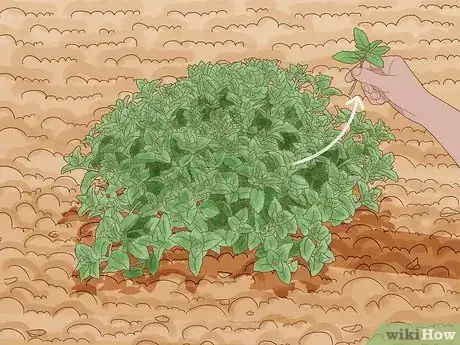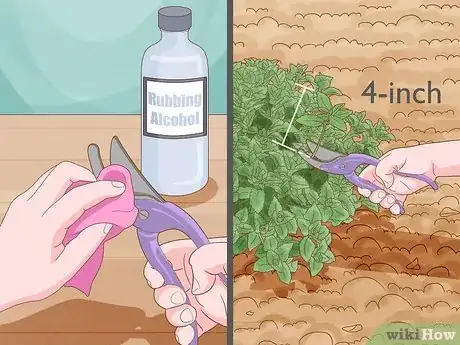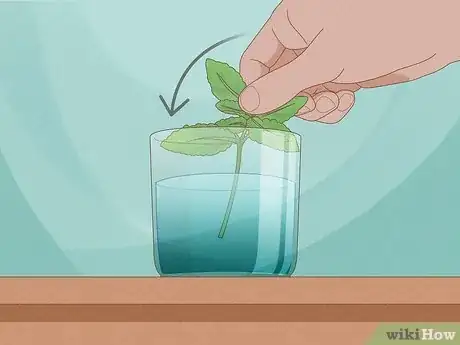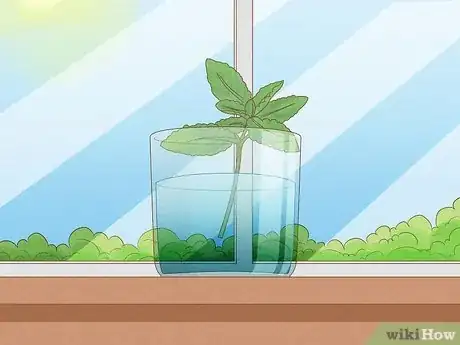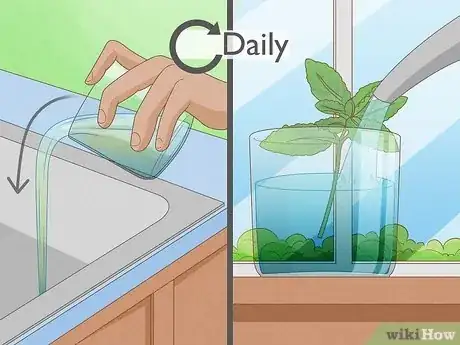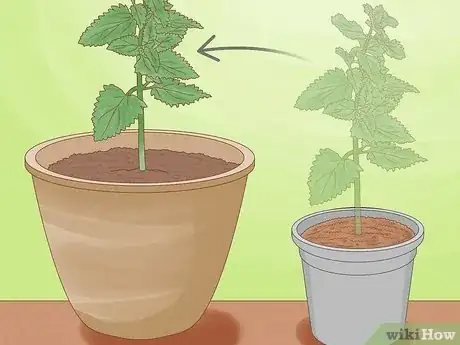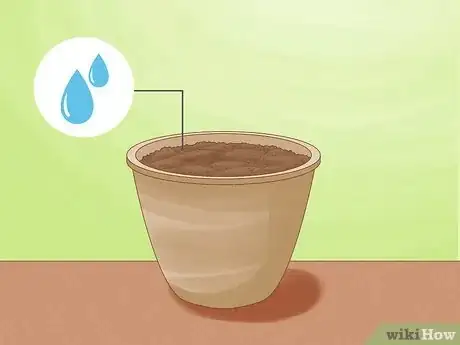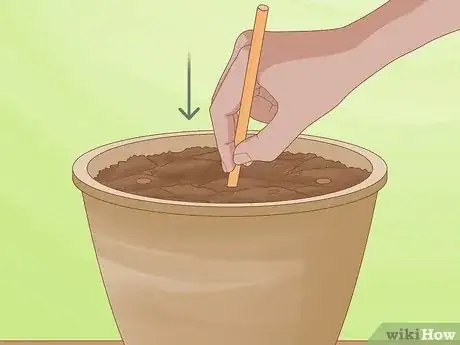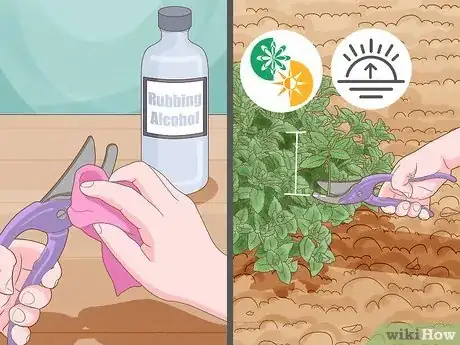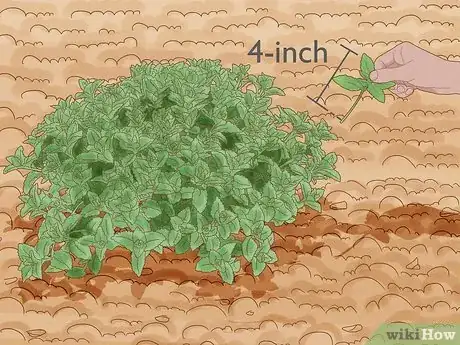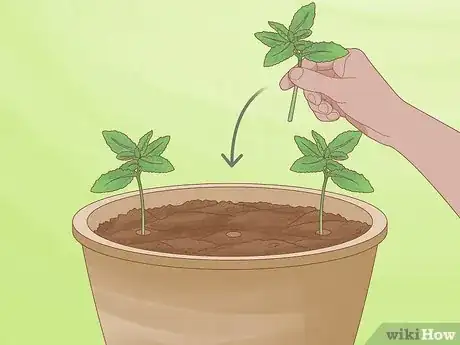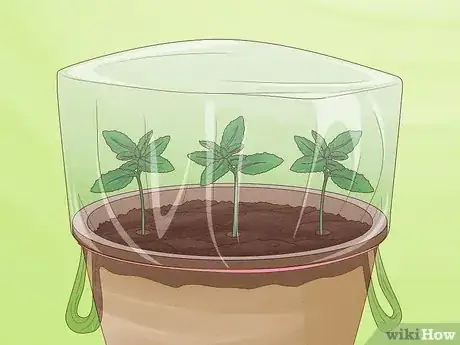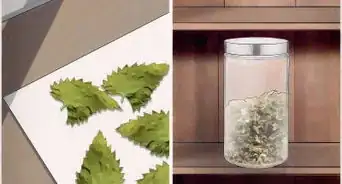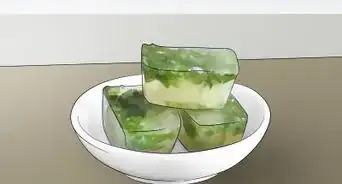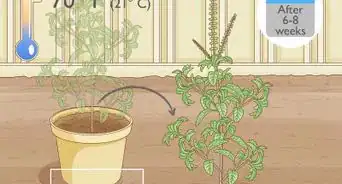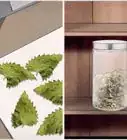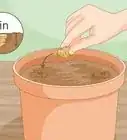X
This article was co-authored by Katie Gohmann. Katherine Gohmann is a Professional Gardener in Texas. She has been a home gardener and professional gardener since 2008.
There are 10 references cited in this article, which can be found at the bottom of the page.
This article has been viewed 56,887 times.
Catmint, also known as "Nepeta mussinii,"[1] is not to be confused with catnip. While it is still attractive to cats, it also develops lavender-colored flowers along the tips, making it suitable as a border and filler in a garden. You can propagate catmint cuttings in water or in soil.
Steps
Method 1
Method 1 of 2:
Growing Catmint Cuttings in Water
-
1Pick a suitable sprig to take softwood cuttings from.[2] Look for a stem with little to no flowers,[3] and plenty of young leaf nodes or bumps. Pick a stem with new growth, rather than a fully mature stem. The stem should snap when you bend it. If the stem does not snap when you bend it, the plant is too young. If you cannot bend the stem easily, then the plant is too old.[4] The best time to take a cutting is in the morning, during spring or early summer.
- The leaf nodes appear as little bumps along the stem. They are important, as that's where the roots will form.
- If it is not possible to find a sprig without any flowers, choose a sprig with as few flowers as possible, and nip them off. Producing flowers takes a lot of energy, and your cuttings will need all the energy they can get to put out roots.[5]
-
2Cut a sprig from the plant. Sterilize a sharp knife or garden shears with rubbing alcohol, and then cut a 4-inch (10.16-centimeter) section from the top of the plant. Cut at an angle, just below the leaf node. If there is no node 4 inches from the top of the plant, cut at the node closest to the top.[6]Advertisement
-
3Place the sprig in a cup of water. The water should be deep enough to hold several of the leaf nodes. Avoid submerging any leaves in the water, however, or you will risk rotting the leaves.
-
4Find a suitable environment for the cup and sprig. A bright window is ideal, as long as there is no direct sunlight. While sunlight is important for plants, too much sunlight can burn or wilt the leaves.[7]
-
5Change the water daily. Because there is so little water in the cup, it will grow murky and stale quickly. You will need to pour out the old water and fill the cup with fresh water every day until the roots develop. This will take one to two weeks.
-
6Transfer the cutting to a small pot. When the roots are about 1 to 2 inches long, take the cutting out of the water and plant it in a small pot filled with good-quality soil. Make sure that the soil is damp but not soggy. Keep the pot in a bright window, but out of direct sunlight. The pot must have a drainage hole at the bottom.
- Consider dipping the roots in rooting hormone to encourage root development before planting the cutting in the soil.
-
7Transplant the cutting into a larger pot or into your garden. Once the cutting is large and strong enough, you can choose to transfer the plant to a larger pot or your garden. Keep in mind, however, that catmint is an invasive plant. If you choose to plant it in your garden, make sure that you surround it with a brick, plastic, or wood border so that it does not spread over your entire garden. You can also confine your catmint by planting it in a pot or planter under the surface of the soil.
- While not as attractive to cats as catnip, catmint still attracts cats. If you dislike cats rolling over your plants, you may have to protect your catmint by rolling chicken wire over it.
Advertisement
Method 2
Method 2 of 2:
Growing Catmint Cuttings in Soil
-
1Select a suitable pot. Make sure that the pot has a drainage hole in the bottom. If you are planning on using very fine soil, you can prevent it from escaping through the drainage hole by lining the bottom of the pot with a coffee filter. The paper will prevent any soil from escaping through the hole, but it will still let water pass through and drain.
-
2Fill the pot with damp soil. The soil should be good-quality gardening soil with nutrients. It should also be damp, but not soaking wet or soggy. Catmint will also do well in coco peat, perlite, rockwool, vermiculite, and other soilless potting mixes.[8]
-
3Make holes in the soil. Take a chopstick, dowel, pen, or pencil and make a few holes in the soil. You will be inserting the cuttings into these holes, so make as many holes as you have cuttings.
-
4Select a suitable plant to make softwood cuttings from. Look for a stem with little to no flowers and plenty of leaf bumps or nodes. The stem should be easy to bend and snap. If the stem does not snap when you flex it, then the plant is too young to take cuttings from. If the stem does not bend easily, then it is too old. The best time to take cuttings is in the morning, during spring and early summer.
- The leaf nodes appear as little bumps along the stem. They are important, as that's where the roots will form.
- If it is not possible to find a stem without flowers, choose a stem with as few flowers as possible, and pull them off. Producing flowers requires energy, and the cuttings will need that energy so that they can put out roots.
-
5Cut a section from the plant. Sterilize a sharp knife or garden shears with rubbing alcohol, then cut a 4-inch (10.16-centimeter) section from the top of the plant. Cut just below a leaf bump, at a slight angle. If there is no leaf bump 4 inches from the top of the plant, then cut below the closest bump.
-
6Plant the cuttings. Gently tuck each cutting into the holes you have made and pat the soil around the stems. Make sure that there are at least a few leaf bumps on the stem section going into the soil. The roots will grow from these bumps.
- Consider dipping the cuttings in rooting hormone to encourage root development.
-
7Create a mini greenhouse over the cutting. You can do this by placing a glass cloche over the pot, or by draping a plastic bag over it.[9] This will help keep the cutting damp while it grows.
-
8Transplant the cuttings to a larger space. After your cuttings grow a few more sets of leaves, you can move them to a larger pot or a sunny spot in your garden. Keep in mind, however, that catmint is very invasive. To prevent it from taking over your garden, consider reining it in with a brick, plastic, or wood border. Also, cats do find catmint attractive; if you do not wish to have cats rolling around in your catmint, consider protecting it by covering the plant with chicken wire.
- If you are planting multiple cuttings in a garden, choose a location with well-drained soil that gets plenty of sunlight. Plant the cuttings 18 to 24 inches (45.72 to 60.96 centimeters) apart.[10]
Advertisement
Community Q&A
-
QuestionCan stems be dried and kept?
 IdabelleCommunity AnswerYes. To dry them, remove all the leaves and put them on a piece of cardboard in a dry place for a few days.
IdabelleCommunity AnswerYes. To dry them, remove all the leaves and put them on a piece of cardboard in a dry place for a few days.
Advertisement
Warnings
- Catmint also attracts bees. Avoid planting it need entryways, patios, and play areas.[11]⧼thumbs_response⧽
Advertisement
Things You'll Need
- Catmint
- Sterile gardening shears or a sharp knife
- Cup and water (method 1)
- Small pot with soil (method 2)
- Dowel, pen, or pencil (method 2)
References
- ↑ Gardening Know How, Catmint Herb: How to Grow Cat Mint
- ↑ Cornell University, Catmint
- ↑ Mother Earth Living, Growing Herbs from Stem Cuttings
- ↑ Fine Gardening, Propagate Your Shrubs from Softwood Cuttings
- ↑ Mother Earth Living, Growing Herbs from Stem Cuttings
- ↑ Mother Earth Living, Growing Herbs from Stem Cuttings
- ↑ Mother Earth Living, Growing Herbs from Stem Cuttings
- ↑ Herb Gardening, How to Grow Catnip or Catmint
- ↑ Better Homes and Gardens, Make More Plants from Cuttings
- ↑ Garden.org, Catmint
- ↑ Gardening Channel, How to Grow Catmint
About This Article
Advertisement
